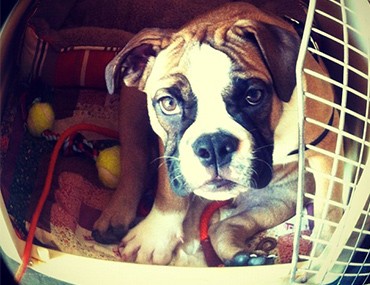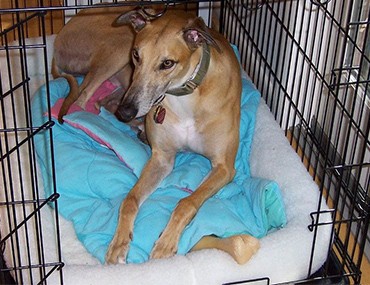Just like people, pets need a place of their own. While a cat might seek refuge on a sunny window sill and teenagers might slam and bolt their bedroom doors, a dog often likes nothing better than the peace and quiet of a crate. Crates provide many benefits to the happy pup, as well as his family. They provide a place to relax, an excellent environment to learn house-training manners, a safe place to spend time when people are away, a dining area (especially in a multi-pet household), and a place to call his or her own.
Our guidelines for the perfect canine hangout:
1. Choose the appropriate crate.
It should be large enough for your pet to stand up and turn around in. However, it should not be so large that your dog could easily do his business in one corner and sleep in another (especially for the young dog learning to be house trained). There are many styles of crates available and some allow you to partition the crate so that you can make the area smaller for a young puppy and then expand it as your dog grows.
2. “Decorate” your dog’s crate appropriately.
While your pooch should be comfortable, you want to be careful that anything you put inside won’t get him or her into trouble: bedding should be washable and not dangerous if ripped or chewed, toys should be safe and not a choking hazard, and food and treats should be limited to appropriate quantities. And always ensure your pet has water if he or she is going to be confined for an extended period of time.
3. Keep in-crate time reasonable.
Sleeping overnight in a crate, taking naps during the day, and being confined (especially younger dogs) during your workday are all reasonable. However, if you need to be away more than 4-6 hours, consider hiring a dog walker or ask a friend to come in and give your dog a trip around the block.
4. Make it the coolest spot in town.
Going in the crate should always be a reward, never a punishment. The crate should always have treats, toys, or food waiting. It should never be the place you send a dog if he misbehaves.
Some families find that the best location for a crate is where all the action in the house takes place, like a kitchen or living room. Others find that the crate should be in a separate, quiet room where the dog is alone. Experiment and find out what is best for you.
Training a Dog to Be a Happy Crate Dweller
First, we can’t stress enough how great crate training is for any puppy or younger dog — both for him and for everyone he lives with. We recommend starting as soon as you bring your dog home. Have a crate waiting and introduce the crate by tossing treats inside and letting your dog go in on his own. Start using a consistent word or phrase to tell your dog to go into his crate (“get in your crate” or “crate time”).
 The first time you plan to have your puppy or dog stay in the crate should be after he’s played and is a little tired; also, be sure he’s recently gone outside for a bathroom break. Encourage him to go into the crate with some treats, praise him when he goes in, and then shut the door and leave without making a big deal.
The first time you plan to have your puppy or dog stay in the crate should be after he’s played and is a little tired; also, be sure he’s recently gone outside for a bathroom break. Encourage him to go into the crate with some treats, praise him when he goes in, and then shut the door and leave without making a big deal.
Be warned, 99.99% of all puppies, and even older dogs, will cry the first few to several times you do this! But just like with a human baby, don’t give in — otherwise they’ll never stop, because they always get their way! Start with short stays in the crate, maybe 15 minutes. When letting your dog out, make sure he or she stops crying first. You might have to tell him to be quiet with a firm “no” or “no bark.” Make sure not to give any treats when your dog comes out of the crate, because that will make him seek a reward for getting out, NOT getting in.
As time goes on, make the experience a little different by introducing new toys, including those that actually give the dog something to do, like figuring out how to get treats out of the toy. Your veterinarian will have recommendations for these more “constructive” toys.
For older dogs, even fully house-trained ones, a crate can still be a wonderful thing. It provides them with them same sense of security and, in multi-pet homes, a place for relaxation and time away from their siblings (including the human ones). Crates help dogs with separation anxiety, those with destructive tendencies, and they come in very handy when you might have to be away for longer than normal.
Just remember: crates are always the reward, never the punishment: don’t give in when your dog protests (otherwise, it will never stop), and keep time in crates reasonable.
If you have any questions or concerns, you should always visit or call your veterinarian – they are your best resource to ensure the health and well-being of your pets.
The opinions and views expressed in this post are those of the author's and do not necessarily represent the beliefs, policies or positions of PetHealthNetwork.com, IDEXX Laboratories, Inc. or its affiliates and partner companies.
